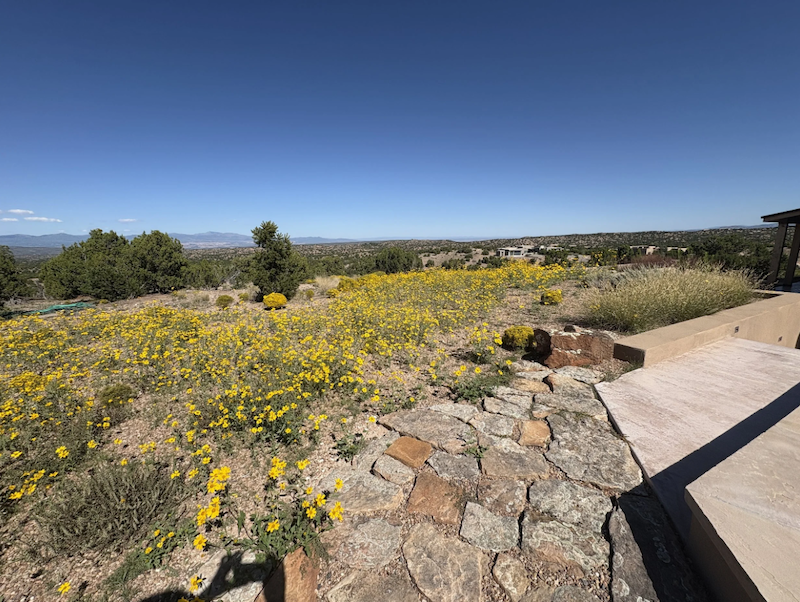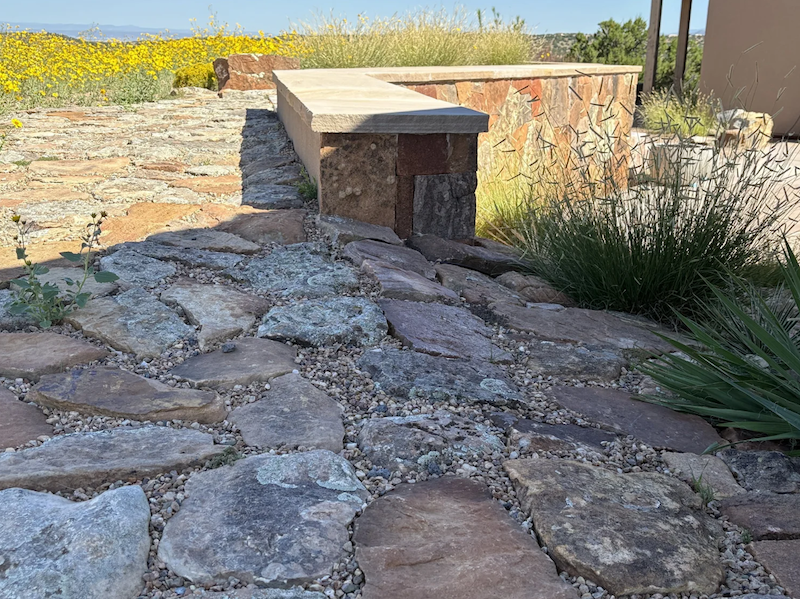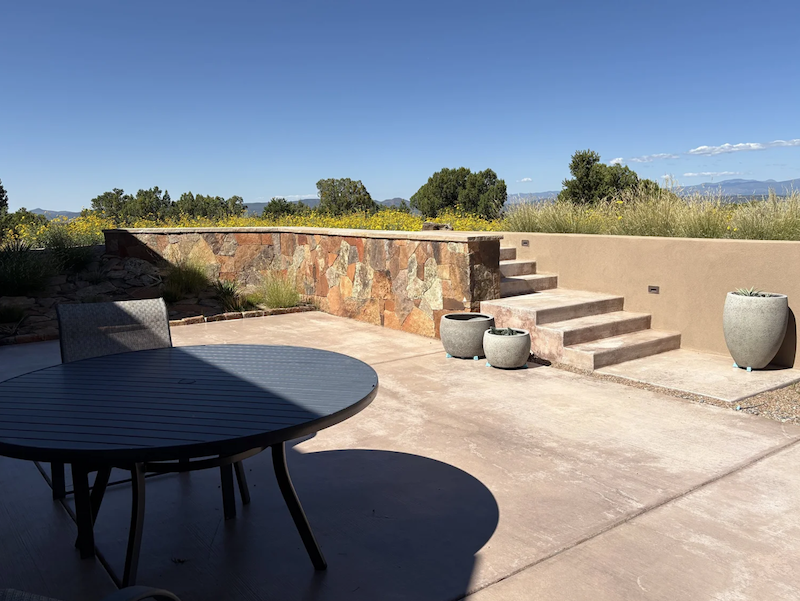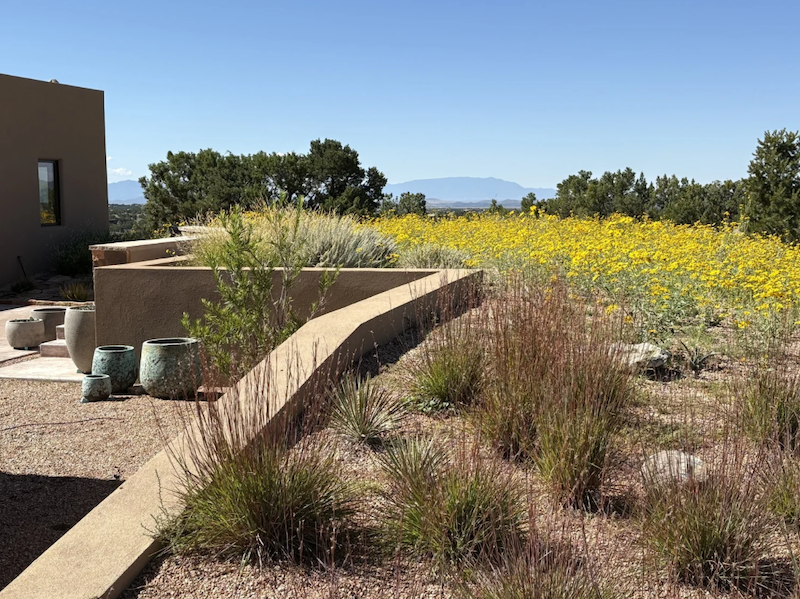|
By Felicia Fredd, Enchanted Garden Productions I visited a garden-in-progress this week to check on the results of a seeding project that began last year, and what I found was a great surprise: a thick crop of Cowpen Daisy! The project, a recent home build just outside of Tesuque, NM, is situated on a somewhat windswept high point that provides huge landscape views in all directions. The views were the client’s primary attraction to the site. I love views too, but I tend to prefer them from a more private and perhaps ‘grounded’ garden space (see prospect-refuge theory: https://www.archpsych.co.uk/post/prospect-refuge-theory). So, the minimalist emphasis on distant views and spatial openness throughout design planning was an interesting experience for me (I’m practically agoraphobic). Neither are the clients what I would call gardeners. They prefer other forms of strenuous exercise, and have never expressed a desire to change the fundamental character of the surrounding landscape. They accept its spareness and often harsh exposures, and felt they needed only to anchor the building with native plants and to revegetate areas disturbed by construction activity. The area above and behind a retaining wall that supports a sunken patio is one of the zones most disturbed during construction (see photos below). We designed the wall as a long low ‘horizon line’ to emphasize the profile of distant mountains and ridge lines. In that sense, the field behind it also serves as an important foreground design element, and our intention here was simply to restore the original low-growing native grass and wildflower community, for the most part. Seeding for the area was completed last fall - the natural time for grasses to drop ripened seed - and our seeding method was to cast into a thin layer of ¼” Santa Fe Brown crushed gravel. This was an experiment in seeding without hydromulch, tackifiers, straw, matting, etc., while still providing some protection from wind displacement and predation, and to help retain moisture. With supplemental watering last spring, the area flushed with tiny green seedlings, including the targeted native grama grasses. As this is their first growing season in very thin, dry soil, the grasses are still quite small, but what did show up with a bang was Cowpen Daisy (Verbesina encelioides). At first, we didn’t realize the Cowpen Daisy accounted for so much of our spring seedling flush. We hadn’t included it in our seed mix, and unless some of our seed packets from Plants of the Southwest had been mislabeled, the Cowpen Daisy seed must have already been present in the soil. Once we figured that out, we chose to let it stay - reasoning that it would at least provide benefits such as shade and wind protection for the young grasses just beginning to establish. It was a good decision. Now, I don’t think you could convince too many people that native Cowpen Daisy is a proper garden plant. There’s just something about its generic, somewhat rangy leaf texture and form that kind of screams “weed”. Most of the time I’ve seen it up close it’s also been pretty dehydrated. I’ve walked through many crunchy, midsummer, drought-stricken fields of these plants and wouldn’t describe them as “beautiful.” But right now, in full bloom following recent heavy rains, it’s a head-turner. In the specific context of this garden it’s gorgeous - another vivid fall gold seen against a background of crisp sky blue. One of the things that helps change the perception from weed to wonderful is a narrow foreground ‘screen’ planting of irrigated native grasses just above the wall. These help push back the Cowpen Daisy field visually, where it is seen less distinctly as just a wash of golden color rolling into the horizon. The coolest part of this accident is that Cowpen Daisy also happens to be a really important late-summer/early fall nectar and habitat plant for native insects. It’s one of our primary Ecoregion 10 keystone species: https://www.epa.gov/eco-research/ecoregions-north-america. And, with so little work, we gained so much beauty and ecological value - all of which relates back to my previous article, How To Love Your Garden, where I tried to say something about how helpful it is to focus on things that work more effortlessly in the garden, and to build on them. I don’t think it would interest the most content-with-the-basics clients I’ve ever known (they haven’t even filled their seasonal pots), but I’d be tempted to add something like Broom Snakeweed (Gutierrezia sarothrae) to this scene. Though it may sound a little weird, Broom Snakeweed is another rugged self-sustaining native keystone species, and the shift in form and texture would subtly tweak that golden scene into something even more visually intense, while also conveying a bit more intentionality. There’s definitely something about a sense of intentionality and staging that helps make a space feel special - even if it’s just how you frame a view or place a chair. I like to be involved with new garden development for a good 3-4 years, if not longer, because it’s the only way to really get all those studied adjustments and fine-tuning sorted out - the seasonal shifts, the editing, the perfect additions, etc., and the Cowpen Daisy was a great unplanned success to build those things out from. Cowpen Daisy against views of Pajarito Plateau. Retaining wall feature stonework by John Morrison. Moss rock plated circulation pathways by Eduardo Aragon. Another angle showing a bit of 'Blonde Ambition’ Grama Grass in the upper retaining wall beds. South facing view with foreground Little Bluestem planting in their second year. Next Fall, I would hope to see the Cowpen Daisy rolling right through the Little Bluestem grid to join the whole area together visually.
0 Comments
Your comment will be posted after it is approved.
Leave a Reply. |
Submit your ideas for local feature articles
Profiles Gardening Recipes Observations Birding Essays Hiking AuthorsYou! Archives
October 2025
Categories
All
|




 RSS Feed
RSS Feed